When the Action Leaves the Museum: New Approaches to the Exhibition as a Tool of Communication, by Eduardo Navas
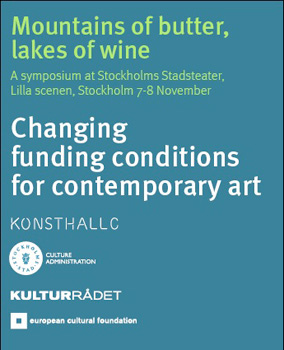
Image source: almostreal.org
Written for Swedish Traveling Exhibitions, December 2009
Note: The following text is one of two originally published in the magazine Spana!, a publication for the Swedish Traveling Exhibitions (now called Swedish Exhibition Agency). I never got around to releasing the English version of the text until now. It contextualizes how I saw exhibitions developing in Sweden during my residency. It starts with a lecture I attended during an international symposium on contemporary curatorial practice, and revisits notes on the different art institutions I visited during my residency in Sweden in October and November of 2009. This publication in many ways is a complement to the list posted below.
The second text is Code Switching: Artists and Curators in Networked Culture.
The list of previous posts:
Sweden: October/November 2009
Notes on Sweden’s Approach to Art and Exhibitions:
Färgfabriken: https://remixtheory.net/?p=401
Interactive Institute: https://remixtheory.net/?p=402
Magasin 3: https://remixtheory.net/?p=403
Iaspis: https://remixtheory.net/?p=404
Mejan Labs: https://remixtheory.net/?p=405
Various Museums in Gothenburg: https://remixtheory.net/?p=406
———–
At the end of 2009, the international approach to exhibitions across museums and public institutions appears to emphasize themes over history. This trend was recognized by Curator Jan Debbaut on Saturday November 7, during his presentation at the Symposium “Mountains of Butter, Lakes of Wine,” which took place at the Stadsteater, Stockholm. This shift has not only changed the way exhibitions are funded internationally, as Debbaut noted, but also how they are approached and contextualized. In 2009, the thematic approach repositions exhibitions as forms of communication beyond the four walls of the galleries, affecting all types of exhibiting institutions, not just museums. In my view, this resonates with various institutions I visited in Stockholm and Gothenburg during the months of October and November of 2009, as Correspondent in Residence for the Swedish Traveling Exhibitions. The following is an evaluation of how such institutions organize exhibitions as tools of communication.
The Action Leaves the Museum
During his presentation, Debbaut, who is the former head curator of the Tate, also explained that prior to the 1980’s, museums in Europe and the United States were in large part supported by the government, but that during the 1980s and 90s the museum infrastructure increasingly began to incorporate funding from both private and public sources. Debbaut elaborated that these developments were supported by the rise of mega-galleries (Gagosian), mega collectors/foundations, private and public contemporary museums (Saatchi, Pinault), artfairs, and the open interest in the artworld to become market-driven. He further argued that this period incorporated the ongoing development of new histories (gender, diversity)/new narratives, the concept of time sharing of art objects as well as the development of a different infrastructure with a set of experts and management, sensitive to a hybrid global economy—that, as previously noted, consists of private and public funding. He also noted that a lot of these changes were influenced by the role of new media. Another development that Dubbett mentioned—which may perhaps be most important for exhibitions as mediums—is that due to the many changes already noted, the “action left the museum.” Meaning that places such as art spaces and biennales developed a pronounced position in the international art scene. The result, he argued was that the museum, as an institution, had to rethink its role in culture.
It is my assessment that this new model of cultural production results in approaching exhibitions as a process—that is an ongoing conversation with the public. Nevertheless, while the action may be with art spaces and non-profit galleries, these places have to make sure that they also stay relevant because the action does not necessarily stay with them: it moves anywhere due to the possibilities offered by the new state of globalization supported by networked culture.
Beyond the Four Walls in Gothenburg
In Gothenburg, The City Museum, Maritime Museum as well as the Museum of World Culture explained how they develop exhibitions according to the constant feedback that they receive from their visitors. They often rely on new media technology and strategies in order to make their exhibitions relevant to a contemporary audience.
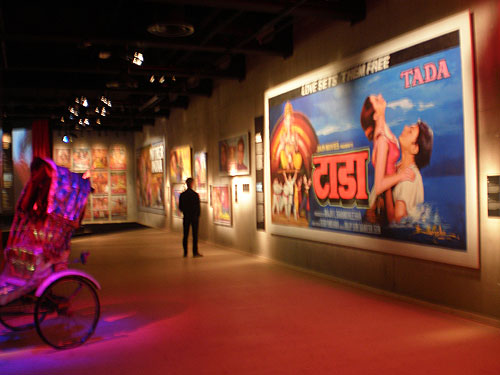
Bollywood,” an exhibit on the film industry in India, at display at the Museum of World Culture until May of 2010. Read original post.
The Museum of World Culture’s primary interest is to develop displays that are sensitive to global cultural shifts, which has led them to acquire a collection according to the necessity of each exhibition. Cajsa Lagerkvist, Head of Exhibitions and Research, along with her colleagues explained during a discussion that building a collection is not their main driving interest, although the museum inherited a collection from Gothenburg’s earlier investment in Ethnography during the nineteenth century. Many of the items on display during exhibits are borrowed from different parts of the world. Some of them may become part of their collection, but this is not always the case, as objects are often returned to their places of origin. At the time of my visit, the museum had two major exhibits, “Vodou” and “Bollywood.” Both exhibits presented material partly borrowed directly from respective areas of the world; in the Case of Vodou, it was Haiti, and in the case of Bollywood, India.
The Museum of World Culture in an innovative outreach effort is using new media technology to connect with its audience. They are developing a guided tour that can be downloaded to cell phones. The tool is in its beta stage, but they hope to release it in the near future. The guided tour is deliberately designed for a new generation of visitors who tend to use their mobile devices for just about every daily activity. As Britta Malmberg who is Head of Education and Audience Work explained, the tour can be downloaded by anyone, and the users do not need to be inside the museum to download the software application. In essence, this is a way of extending the exhibition beyond the museum’s walls to the local community; a possible result is that people may be able to preview what they will encounter prior to their museum visit.
A Virtual Aquarium display at the Maritime Museum. Direct camera feed from the ocean. Read original post.
The Maritime Museum, similarly to the Museum of World Culture is also quite sensitive to the needs of their audience. The Director Anna Rosengren explained that curators design exhibitions with the purpose to develop an ongoing relationship with their audience. The Maritime Museum actually has some of the youngest visitors in the city, which makes sense given that children are attracted to myths of pirates and the sea. Needless to say that there were a few pirate mannequins at the main entrance of the museum. Curators Britta Söderqvist, Linda Noreen and their colleagues explained how they implement new media to engage their audience. For instance, when visiting their main exhibit space, which at the time of my visit offered a historical glimpse of the seaport, one can learn about the figureheads usually placed at the front of ships. These heads are placed high around the four walls of the main exhibition gallery. Visitors can learn about particular heads by using a ship’s steering wheel to point a camera. On a screen, a description and history of the particular head appears. The exhibit also featured a virtual aquarium, which consisted of an LCD screen presenting a web camera stream from the nearby ocean. Visitors could observe fish and other ocean life in their natural environment. But most importantly, aside from using actual new media technology in a very direct way, the curators approach to exhibitions makes evident that they are thinking of displays as a means to create discourse more than anything. In this regard, Noreen heads a project titled “Shoreline,” in which teenagers are encouraged to reflect on their experiences of living in a seaport city through art, writing, and other creative forms of communication. The works are installed in one of the museum’s galleries. Much of this activity is extended online via a website which documents the kids’ work in different media. This may well be a literal example of how the exhibit moves beyond the gallery walls. These exhibitions also demonstrate that Debbaut’s observation that “the action has left the museum” is a reality that both The Museum of World Culture, as well as the Maritime Museum are coping with constructively, by finding ways to make exhibitions available on the cell-phones and the Web, respectively.
To this effect, The City Museum, like its sister institutions, is also very sensitive to the needs of its audience, and is exploring possible new approaches to the exhibition as a process and form of communication. Curator Christian Penalva and Project Manager Charlotta Dohlvik, along with three of their colleagues explained that the museum is redesigning many of their permanent installations in order to be sensitive to audience interaction. This was quite interesting to learn given that, out of the three institutions I visited in Gothenburg, the City Museum fits well within the usual museum definition as a repository of archeological and ethnographic artifacts; its hybrid collection falls under the term cultural history. The museum holds a number of important archeological pieces from the Viking era as well as artifacts from the early days of trade in the eighteenth and nineteenth century; it also hosts an impressive collection of Swedish theatre and dance costumes.
Curator Christian Penalva explained the museum’s interest in implementing innovative approaches to exhibiting, which is why it supports contemporary issues while promoting the city’s history. At the time my visit, The City Museum featured selections of the Gothenburg Art Biennale, titled “What a Wonderful World,” curated by Celia Prado and Johan Pousette.
The approach to the exhibition as a process and form of communication, often with the implementation of new media, appeared to be a relevant framework for the three museums. Along these lines, The Museum of World Culture’s mission statement is a clear example of how public institutions are dealing with the action taking place beyond the exhibiting space: “The museum wants to be an arena for discussion and reflection in which many and different voices will be heard, where the controversial and conflict-filled topics can be addressed, as well as a place where people can feel at home across borders.” I also found “the arena for discussion” at play in other spaces I visited in Stockholm.
Beyond the Four Walls in Stockholm
Stockholm hosts two spaces that are sensitive to the issues so far discussed, but which are also directly invested in new media, albeit with different models. The first is the Interactive Institute, a research center that supports new media design projects that at times may develop into actual business startups. The second is Mejan Labs, a gallery that functions as an extension of the Royal University College of Fine Arts. It focuses on new media as an art practice.
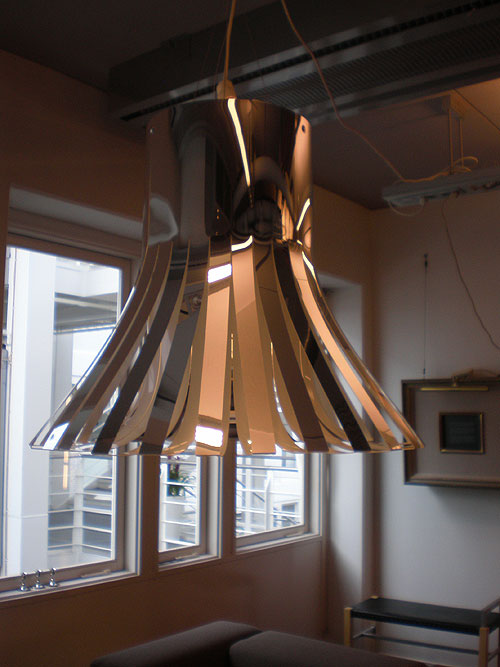
Flower Lamp, which is part of a set of projects under the concept of Visual Voltage at The Interactive Institute. Read the original entry.
As its name implies, the Interactive Institute supports projects that explore the concept of interactivity. During my conversation with Studio Director Halina Gottlieb I learned that the Interactive Institute researches user interaction as a process not only of discovery, but also of communication. To this effect, the project titled Flower Lamp is designed to react to the amount of energy consumed in a home or office. When its metallic petals open, it means that less energy is consumed; the opposite takes place when they close. This project communicates the flow of energy. The premise is that users will become aware through constant feedback how they consume electricity. Communication becomes a means for education in this instance.
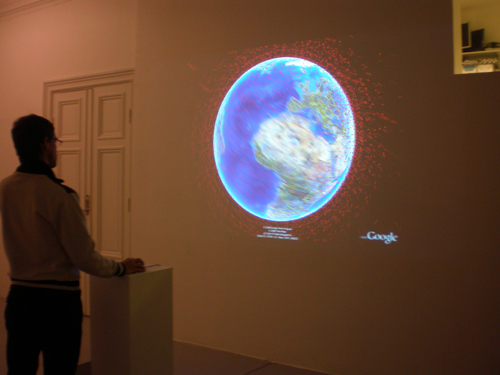
Installation view of “Space Junk Spotting” (2006) by Saso Sedlacek at Mejan Labs. Read the original entry.
Mejan Labs is an art space dedicated to supporting projects that critically reflect on diverse forms of technology. Director Peter Hagdahl and Curator Björn Norberg discussed with me how Mejan Labs is part of the ongoing development of new media art practice in Sweden.
At the time of my visit, Mejan Labs featured three works that focused on Astronomy. A project worth of note is Space Junk Spotting by Saso Sedlacek. The artwork is a software mashup, which implements NASA database information about space junk on top of Google Earth. The installation encourages users to explore a virtual representation of debris that circulates the planet. The work made apparent the established tendency of new media installations exhibited in galleries to point outside the space as a means to validate their authority as objects sensitive to real issues. At this point it is opportune to revisit Debbaut’s observation on action and the museum to note that Space Junk exposes how the user interacts with the software application as an installation. In effect, the new media project demonstrates how the gallery is now a transitional space in which users can become engaged in some level, but that if they have enough interest after their visit, they could download the software in the privacy of their homes to further explore the artwork. This is specific to new media, and is a direct extension of the “action leaving the museum.”
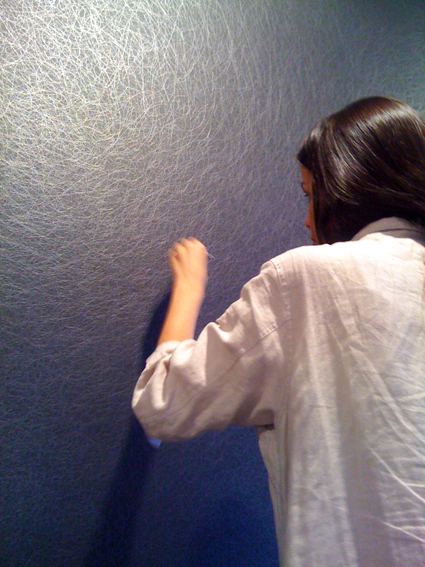
Wall Drawing #715”, February 1993
On a black wall, pencil scribbles to maximum density. Pencil.
Courtesy Estate of Sol LeWitt
See original post
When the action leaves the four walls of a gallery, a concrete challenge comes about when trying to build a respected collection of contemporary art. One way to deal with this issue is to embrace the flux in exhibitions as forms of communication. This may very well be one of the reasons why Magasin 3 actually presents itself as an art space that reaches beyond its physical location. Their online description reads: “Magasin 3 Stockholm Konsthall operates as an independent philanthropic activity by the privately owned group Proventus AB.” Note how the statement does not validate the space as a location, but as a type of process: “an activity.” Curator Tessa Praun explained to me the philosophy behind Magasin 3; and indeed, I encountered many of the same principles of outreach used by other institutions I visited in both Gothenburg and Stockholm. Exhibits at Magasin 3 become pivots around which ongoing events, including lectures and discussions are organized. As I listened to Praun, I got the sense that the different events promoted cultural value, which in turn made the works relevant in more ways than mere physical forms on display; the installations became activated as ideas that people could take with them. The curatorial philosophy at Magasin 3, as I understood it, appeared to make the most of this possibility.
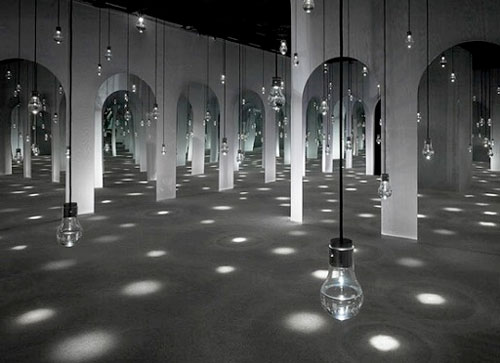
Image source: Takram.com
Overture, Installation: Milano Salon, Italy, April 22-27, 2009.
Collaborative work by Kotaro Watanabe, Iaspis Artist in Residence
Read original entry
Iaspis, an international artist in residence program, shares some philosophical similarities with Magasin 3, not so much in terms of its infrastructure, but more in terms of how to reach an audience and keep its interest. I met with Coordinator Suzi Ersahin, who took me around the facilities while explaining Iaspis’s role in Swedish culture. The online description reads:
Iaspis was founded in 1996 as the Swedish Visual Arts Fund’s international programme commissioned to support international exchange for practitioners in the areas of visual art, design, craft and architecture. Iaspis’ activities aim to enable practitioners based in Sweden to develop artistically and improve their working conditions by establishing international contacts between artists and institutions, professionals such as curators and critics and others active in the field.”
Again, this is an art center, quite different from the exhibition spaces so far discussed, yet it uses similar language to define itself as a place in which to engage in terms of discussions and process. The institution could present itself more directly as a space that facilitates studios for artists—but this appears to be taken for granted in their mission statement.
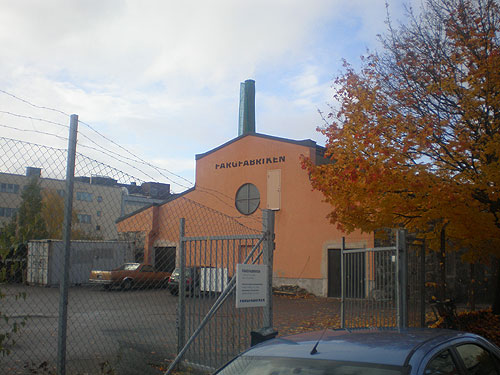
Front facade of Färgfabriken, a former paint factory turned into an art space in 1996. Read original entry.
Fargfabriken, a former paint factory turned into an art space, presents its exhibitions as forms of process, which, unlike the other art spaces and institutions emphasizes its physical presence. Their website states: “Färgfabriken is an art gallery that works in three different principal areas: art, architecture, and society. Our work creates the conditions for questioning, developing, and creating unexpected situations.” This description may come closest to recognizing an institution as a location to visit, but it quickly shifts the attention to a discourse that moves beyond the space itself. Project Manager, Fia Palmgren explained that the art space often organizes public activities and workshops to engage their community.
The Swedish Traveling Exhibitions, the place that hosted me as Correspondent in Residence, is actually no exception when considering exhibitions as forms of communication. In fact, the institution has been invested in this concept since it was founded in 1965. Its website states: “We build exhibitions, tour with exhibitions and train people in how to work with exhibitions. […] We seek to help people to understand and influence their own time. Exhibitions are our tool.” During my interval stays in Visby, a small town located in the island of Gotland, where The Swedish Traveling Exhibitions is based, I experienced how exhibitions as mediums of communication play out as an activity, a process, and form of communication. The staff makes possible traveling exhibitions of all types throughout Sweden, in all forms possible, including an 85 square-meter mobile display unit that can hold up to 50 people. If the action left the museum as Debbaut noted in his presentation at the “Mountains of Butter” symposium, then Swedish Traveling Exhibitions began to explore how such action takes effect before it became an expected element in a global market at the beginning of the twenty-first century.
Beyond the Four Walls onto the Informational Layer
It can be argued that exhibitions have always been about extending culture beyond its gallery walls. While this may be true, what must be acknowledged, as demonstrated above, is that the transparency of exhibitions being—more than anything—forms of communication is emphatically promoted in the mission statements of the institutions I visited in Gothenburg and Stockholm; however, the reason for this emphasis on exhibitions as tools of communication is not particular to Swedish culture. Due to the ubiquity of networked communication, communities around the world have entered a new stage, which is defined by art and media theorist Jose Luis Brea as a fourth layer of economic production, which he references as immaterial work. This layer is above the layer of agriculture, industrialization and service. It is a layer that treats constant information exchange—communication itself—as a commodity. This shift appears to have influenced the Swedish cultural institutions that I visited, and can be demonstrated by remixing selected key phrases taken directly from their mission statements: The challenge at the end of 2009 is to embed oneself in an activity (Magasin 3) within an arena (The Museum of World Culture) in order to support international exchange (Iaspis) for questioning, developing, and creating unexpected situations (Fargfabriken) by using exhibitions as tools (Swedish Traveling Exhibitions). The remixing of these phrases and terms makes evident how, when the action leaves the museum, even institutions that benefit from such flux need to adopt a strategy of constant redefinition as a process in itself. They need to become primarily forms of communication.








